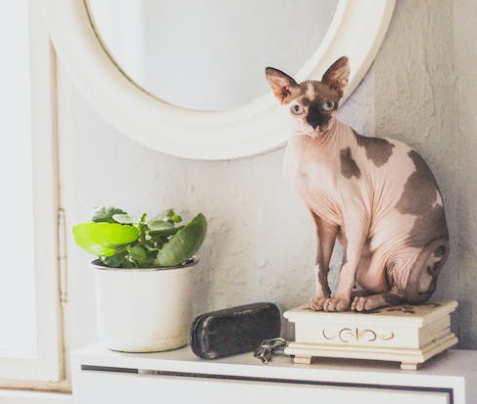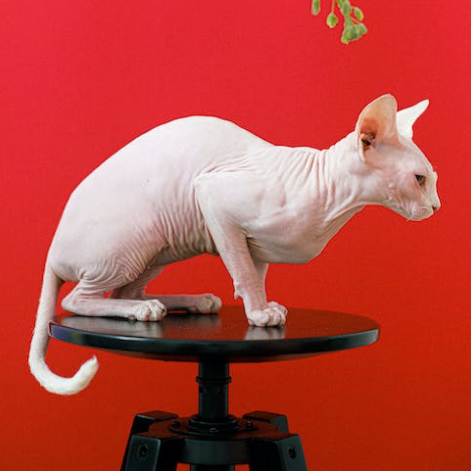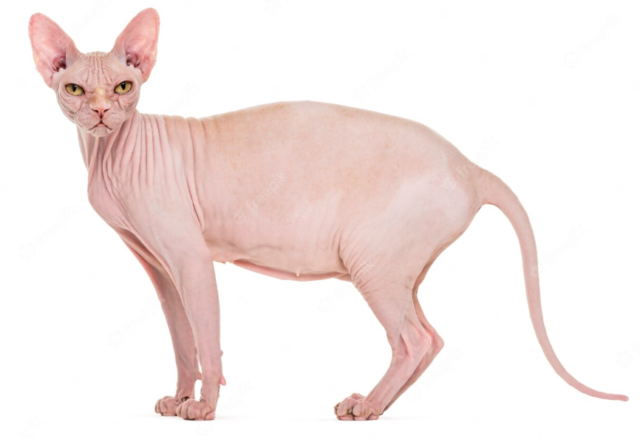Introduction
The fat hairless cat, sometimes referred to as the sphynx cat, is a rare and intriguing breed with unusual traits. These cats are distinct from other feline friends since they don’t have fur. The health aspects, diet and nutrition, skin care, physical characteristics, exercise and enrichment, behavioral tendencies, genetic history, and their appropriateness as pets will all be covered in this article. Let’s explore the world of fat hairless cats and learn why they are so unique.

Health Considerations for Fat Hairless Cat
A. Skin Care and Maintenance
Due to their lack of fur, fat hairless cats require special attention to their skin. Regular bathing is necessary to keep their skin clean and free from excess oils. Gentle hypoallergenic shampoos should be used to prevent skin irritation. Additionally, moisturizing the skin with a cat-friendly lotion or oil helps maintain its health and prevent dryness.
B. Weight Management and Related Concerns
Fat hairless cat has a tendency to gain weight easily, which can lead to various health issues. It is crucial to monitor their calorie intake and provide a balanced diet to prevent obesity. Regular exercise and playtime are essential for weight management and overall well-being.
C. Increased Susceptibility to Environmental Factors
Being hairless, these cats are more susceptible to extreme temperatures. They are prone to getting cold easily, so it is important to keep them warm during colder seasons. On the other hand, they can also be sensitive to excessive heat, so it’s vital to provide a cool and comfortable environment during hot weather.

Diet and Nutrition for Fat Hairless Cat
A. Balanced Nutrition Requirements
The fat hairless cat needs a balanced diet to meet its nutritional needs. High-quality cat food that contains a mix of protein, fat, and carbohydrates is essential. A consultation with a veterinarian is recommended to determine the proper diet plan for your specific cat.
B. Special Dietary Needs
Some fat hairless cats may have specific dietary needs, such as allergies or food sensitivities. In such cases, it is important to identify and eliminate potential allergens from their diet. Limited-ingredient diets or hypoallergenic cat food can be beneficial for cats with dietary sensitivities.
C. Weight Control Measures
As mentioned earlier, weight control is crucial for a fat hairless cat. Feeding them measured portions and providing interactive feeding toys can help slow down their eating pace and prevent overeating. Regular exercise, such as interactive play sessions, also aids in weight management.

Grooming and Skincare for Fat Hairless Cat
A. Bathing Techniques and Frequency
Bathing fat hairless cats should be done regularly, approximately once every two to four weeks. Use lukewarm water and a gentle cat shampoo to cleanse their skin. It is important to ensure that the cat is fully dry after bathing to prevent any discomfort or skin issues.
B. Moisturizing the Skin
Moisturizing the skin of a fat hairless cat is crucial to prevent dryness and maintain its health. Use cat-friendly moisturizers or oils recommended by a veterinarian. Apply the moisturizer after bathing or as needed to keep the skin supple and hydrated.
C. Protecting the Cat from Extreme Temperatures
Fat hairless cats are more susceptible to extreme temperatures, so it’s important to protect them accordingly. During colder months, provide them with warm bedding, clothing, or heated areas. In hot weather, ensure they have access to cool and shaded areas to prevent overheating.
Physical Features of Fat Hairless Cat
A. Lack of Fur and Its Implications
The absence of fur is the most distinctive feature of a fat hairless cat. It means that their skin is directly exposed to the environment. This makes them more prone to sunburn, skin damage, and scratches. Regular skin checks and protection from harmful UV rays are important to maintain their well-being.
B. Pronounced Body Structure and Weight
Fat hairless cats have a unique body structure characterized by a round belly and a sturdy build. Their weight tends to be higher compared to other cat breeds. Regular exercise and a balanced diet are crucial to prevent obesity and maintain their overall health.
C. Unique Facial Features
Apart from their lack of fur, fat hairless cats have unique facial features that make them easily recognizable. They often have large ears and expressive eyes, which add to their charm. These distinctive facial features contribute to their overall appeal and make them stand out from other breeds.

Exercise and Enrichment for Fat Hairless Cat
A. Suitable Exercise Options
Despite their lack of fur, fat hairless cats are active and playful. Engaging them in regular exercise sessions helps maintain their physical and mental well-being. Interactive toys, such as puzzle feeders and feather wands, are excellent options to keep them entertained and encourage movement.
B. Indoor Enrichment Activities
As indoor pets, fat hairless cat benefit from a stimulating environment. Provide them with scratching posts, climbing trees, and interactive toys to keep them mentally stimulated. Creating vertical spaces and hiding spots around the house also enhances their overall living experience.
C. Toys and Games to Engage the Cat
Interactive toys and games play a vital role in keeping fat hairless cats mentally and physically active. Toys that mimic hunting behavior, such as laser pointers or treat-dispensing toys, can be highly engaging for them. Rotate the toys regularly to maintain their interest and prevent boredom.
Behavioral Traits of Fat Hairless Cat
A. Temperament and Personality Traits
Fat hairless cats are known for their friendly and affectionate nature. They are often described as social, extroverted, and curious. They enjoy human company and tend to get along well with other pets, making them great companions for households seeking an interactive and sociable pet.
B. Socialization Needs
Proper socialization is crucial for fat hairless cats to ensure they develop into well-adjusted and confident individuals. Introduce them to various environments, experiences, and people from a young age. This helps them become comfortable with different situations and reduces the likelihood of anxiety or fearfulness.
C. Communication Methods
Like all cats, fat hairless cats communicate through various vocalizations, body language, and behaviors. Pay attention to their cues, such as purring, meowing, or tail movements, to understand their needs and emotions. Building a strong bond with your cat and observing their behavior enables effective communication and a deeper connection.

Understanding Fat Hairless Cat
A. Genetic Background and Origins of Fat Hairless Cat
Fat hairless cats, specifically the Sphynx breed, have a unique genetic background. They originated from a natural mutation and selective breeding. The absence of fur is a result of a recessive gene, and careful breeding has ensured the continuation of this distinct trait.
B. Specific Breeds Known for Being Fat and Hairless
While the Sphynx is the most well-known breed of fat hairless cat, there are other breeds that share similar characteristics. These include the Peterbald, Donskoy, and Elf cat. Each breed has its own variations in appearance and temperament, but they all share the distinctive feature of being hairless.
Fat Hairless Cats as Pets
A. Compatibility with Different Households
A fat hairless cat can adapt well to various households and lifestyles. Their social and affectionate nature makes them suitable for families with children, singles, or elderly individuals. However, it’s important to consider their specific care requirements and ensure they receive proper attention and care.
B. Interaction with Other Pets
Fat hairless cats generally get along well with other pets, including dogs and other cats. Proper introductions and gradual acclimation are key to successful coexistence. Monitor their interactions initially and provide separate spaces if needed, ensuring a harmonious environment for all pets involved.
C. Allergies and Sensitivities
Contrary to popular belief, fat hairless cats are not hypoallergenic. While they may produce less allergenic dander compared to furry cats, they still produce allergens that can trigger allergies in susceptible individuals. It’s important to spend time with a fat hairless cat before bringing one into your home to determine if any allergies or sensitivities are present.
Fat Hairless Cat and Allergies
A. Allergy Triggers Associated with Cat Ownership
Cat allergies are primarily caused by a protein called Fel d 1, which is found in a cat’s saliva, skin, and urine. Even though fat hairless cats produce less dander, they still produce Fel d 1. Common allergy symptoms include sneezing, itching, and respiratory discomfort.
B. Allergy-Friendly Cat Breeds
For individuals with allergies, there are certain cat breeds that are considered more hypoallergenic. While fat hairless cats are not completely hypoallergenic, some breeds produce fewer allergens. These include the Siberian, Balinese, and Russian Blue. It’s important to note that individual reactions can vary, so spending time with the specific breed is recommended.
C. Managing Allergies in Households with Fat Hairless Cats
To manage allergies in households with fat hairless cats, regular cleaning and maintenance are crucial. Vacuuming, dusting, and frequently washing bedding can help reduce allergen levels. Air purifiers and allergy medications prescribed by a doctor may also be beneficial in minimizing allergy symptoms.
The Takeaway
Fat hairless cats, or Sphynx cats, are a captivating breed with their unique characteristics and charm. From their distinct physical features to their social and playful nature, they offer a rewarding pet ownership experience. However, it’s essential to understand and address their specific needs, including skin care, weight management, and suitable environmental conditions. By providing proper care, attention, and love, fat hairless cats can thrive and become cherished members of our families.

Meet the Fat, Bald Cat That’s Becoming a Body Positivity Icon
In addition to their other qualities, fat hairless cat, particularly Sphynx cats, have become symbolic of body positivity. Their unique appearance challenges conventional beauty standards and encourages acceptance of diversity. Their popularity as pets has helped foster a more inclusive and accepting mindset, spreading the message that beauty comes in all shapes, sizes, and forms.
Conclusion
In conclusion, fat hairless cats are fascinating and extraordinary companions. Their distinctive characteristics, combined with proper care and attention, make them unique additions to any household. By understanding their health considerations, providing appropriate diet and nutrition, grooming and skincare, and ensuring sufficient exercise and enrichment, we can ensure their well-being and enjoy their delightful company.
Must-Have Products for Fat Hairless Cats
FAQs
Q1: What Is the Best Diet for a Sphynx Cat?
The best diet for a Sphynx cat is a balanced and high-quality cat food that meets its nutritional requirements. Consult with a veterinarian to determine the specific dietary needs of your Sphynx cat based on its age, weight, and any underlying health conditions.
Q2: What Is the Lifespan of a Sphynx Cat?
On average, Sphynx cats have a lifespan of 12 to 16 years. However, with proper care, regular veterinary check-ups, and a healthy lifestyle, some Sphynx cats have been known to live even longer.
Q3: What Happens If You Breed a Hairless Cat with a Normal Cat?
Breeding a hairless cat with a normal cat can result in a litter of kittens with a mix of hairless and normal-coated kittens. The hairlessness trait is a recessive gene, so not all offspring will be hairless. Careful breeding practices and genetic testing are important to ensure the health and well-being of the kittens.
Q4: Is It True That Sphynx Cats Need More Attention Than Other Breeds?
Sphynx cats are known to be sociable and affectionate, which may lead to a perception that they require more attention. While they do enjoy human interaction, their attention needs are not necessarily higher than other breeds. Providing regular companionship, and playtime, and meeting their specific care requirements will keep them content and happy.
Q5: Can Sphynx Cats Be Left Alone All Day?
While Sphynx cats are social creatures, they can tolerate being alone for reasonable periods. However, it's important to ensure they have sufficient mental stimulation, access to food, water, and a litter box. Consider providing interactive toys or even consider getting a companion pet to keep them company if extended periods of alone time are unavoidable.
Q6: Why Do Sphynx Cats Shake?
Sphynx cats may shake or shiver occasionally, especially in cooler environments. This behavior is often a natural response to regulating their body temperature. If the shaking is persistent or accompanied by other symptoms, consult a veterinarian to rule out any underlying health issues.
Q7: How Much Does a Sphynx Cat Cost?
The cost of a Sphynx cat can vary depending on factors such as breeder reputation, lineage, and geographical location. On average, a Sphynx cat can range from $1,500 to $3,000, with show-quality or rare-colored Sphynx cats commanding higher prices.
Q8: Are Sphynx Cats Good Pets?
Sphynx cats can make wonderful pets for the right individuals or families. Their friendly and affectionate nature, combined with their unique appearance, often makes them popular choices. However, it's important to understand their specific care needs, including grooming, temperature regulation, and attention to skin care.
Q9: Do Hairless Cats Smell?
Contrary to popular belief, hairless cats do not inherently have a strong odor. However, they may require more frequent bathing to maintain their skin health. Proper hygiene practices, such as regular bathing and cleaning of their ears and skin folds, help keep any potential odors at bay.
Read also
- Is a Black Persian Cat the Perfect Companion for You?
- How to Choose the Perfect Modern Cat Tree for Your Home
- How to train a cat to use the toilet : Mastering the Art of Training
- How to Introduce a New Cat to My Home | Expert Guide
- How to Stop a Cat from Scratching Furniture | Effective Strategies and Solutions
- Black Maine Coon Cat Breed Characteristics (2023)




